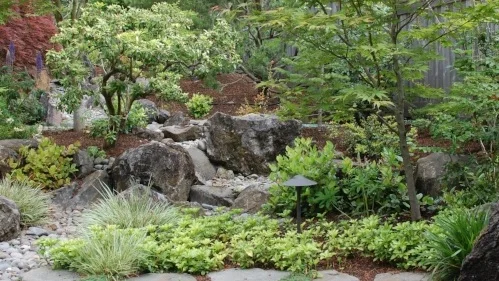Rain Gardens For Portland Oregon
What percentage of your property is roof, driveway, and patio?
When rain hits those areas it is sent to gutters, downspouts, drains, and eventually the sewer. Along the way it gathers oil, chemicals, and garbage. All of this has to be handled by our water treatment infrastructure before it ends up in our rivers (primarily the Willamette here in Portland).
All that rain that should be nourishing plants and replenishing groundwater supplies has to be treated like waste. What a shame, right?
Happily, there is a way to mitigate the effects of all those impervious surfaces. Rain gardens to the rescue!
What is a rain garden?
... Rain Gardening 101
Rain gardens bring a natural process and feature to our created environments- like our front and backyards. If you live in Portland you have probably seen a rain garden, whether you know it or not. Portland has hundreds of rain gardens installed as part of the Green Streets initiative.
If you install a rain garden on your property, or have a Portland area landscape company do it, then you can keep most of the rain that hits your property on your property.
Two key elements to a rain garden.
Drainage. Your rain garden can be large or small, deep or shallow. Whatever the case, it absolutely has to drain. You don't want to create a bog that stays soggy for months in the winter and breeds mosquitoes in the summer. So, before you install your rain garden check your soil. Dig a little hole, about the size of a five gallon bucket, and fill it with water. Once the water is gone fill it again. Check it an hour later. If the water level has dropped an inch or more you have a great spot for a rain garden. Now you can start thinking about point two...
Plants. Plants help filter the water and make your rain garden attractive. The plants you choose need to be able to handle a flood of water at times and drought conditions at other times. Most of the best rain garden plants are native to your area.
Creating a beautiful rain garden.
... Advanced Rain Gardening
Rain gardens are functional, useful, helpful- and that is reason enough to install one. But shouldn't they be beautiful as well? I think so!
The key is to view it as just one part of your garden design, a feature that has to blend with all the other elements of your yard. The plants you choose to go in your rain garden can help make it attractive. The plant material that goes near your rain garden can help it make sense.
If your general landscape style is natural, perhaps native oriented, then the rain garden should fit right in. But if your style is more formal or stylized, then you will have to work a little harder.
View the area around your rain garden as a transition space. Use plant choices, grading, and stone to blend the rain garden with your [whatever your style is] garden. A professional landscape designer or architect could help if the transition is baffling you
“A rain garden is a planted depression or a hole that allows rainwater runoff from impervious urban areas, like roofs, driveways, walkways, parking lots, and compacted lawn areas, the opportunity to be absorbed.”


